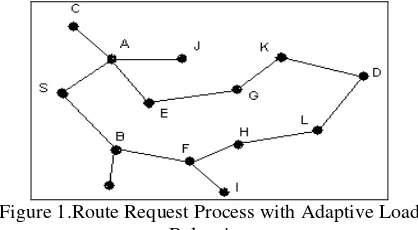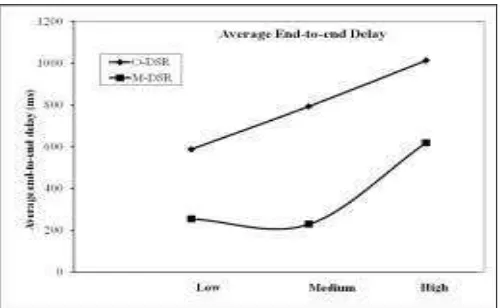www.ijsrnsc.org
Asra College of Engineering & Technology, Punjab, [email protected]
Abstract- A mobile ad hoc network is a collection of wireless mobile hosts forming a temporary network without the aid of any centralized administration or standard support services regularly available in wide-area networks to which the hosts may normally be connected In this paper, we present an effective scheme to balance the load in ad hoc network. The scheme can be applied in most on-demand routing protocols. It is implemented in the process of route request. When route request (RREQ) messages are flooded to acquire routes, Only the qualified nodes, which have a potential to serve as intermediate forwarding nodes, will respond to these messages, so that the established path will not be very congested, and the traffic will be distributed evenly in the network. In this scheme, a threshold value, which is used to judge if the intermediate node is overloaded, is variable and changing along with the nodes’ interface queue occupancy around the backward path. Therefore, we call it an adaptive load-balancing approach and the performance of routing overhead and average end-to-end delay is also improved.
Keywords- MANETs, Routing Protocols, DSR, O-DSR, M-DSR
I. INTRODUCTION
An ad hoc wireless mobile network is an infrastructure-less mobile network that has no fixed routers; instead, all nodes are capable of movement and can be connected dynamically in an arbitrary manner. In order to facilitate communication of mobile nodes that may not be within the wireless range of each other, an efficient routing protocol is used to discover routes between nodes so that the messages can be transmitted timely. A lot of routing protocols have been already presented for mobile ad-hoc network. These protocols are generally categorised into 3 types as table-driven routing, on demand routing and hybrid routing protocols. In Table driven Routing Protocol uses resources to maintain and up-to-date routing information in the form of tables. While on-demand routing protocol does not always maintain routing information at every node, and it only creates route when a packet is desired to transmit. and The Hybrid Routing protocol incorporates the mixed technology of table driven and on demand routing protocol.
In this paper we present an efficient load balancing technique on on-demand routing protocol. Load Balancing is a method to distribute workload across multiple nodes in a network, to achieve optimal resource utilization, maximize throughput, minimize response time, and avoid overload .It is implemented in the process of Route discovery. When a RREQ message is flooded in the network, not every intermediate node, which receives the message, will broadcast it. The node will be first judged by the Threshold value to determine if it is overloaded. If so, the RREQ message will be dropped, and the established route won’t contain this overloaded node. The threshold value used as a criterion is dynamically changing according to the interface queue occupancy of nodes around the backward path.
The paper is organised as follows. Related work is networks so a range of protocols have been proposed. In this section, we will review some problems in load balance for exiting routing protocols in ad hoc networks. The coupling problem is much more serious in single channel networks, where coupling also occurs when one path crosses the radio coverage area of another path. The load-balancing technique in ad hoc networks can be generally divided into two types. The first type is “Traffic-size” based, in which the load is balanced by attempting to distribute the traffic evenly among the network nodes. The second type is the “Delay” based, in which the load is balanced by attempting to avoid nodes with high delay. In this paper, the proposed scheme is applicable to most on-demand routing protocols, either single-path routing or multi-path routing. It belongs to the “Traffic-size” based type, and will distribute the traffic load evenly among the nodes in ad hoc network.
III. ADAPTIVE LOAD BALANCING IN DSR M-DSR is an extension to the DSR protocol for computing multiple loop –free and link- disjoint paths. The protocol computes multiple loop- free and link disjoint paths. To ensure loop-freedom and node only accepts an alternate path to the destination if it has a lower hop count then the advertised hop count for that destination. The proposed adaptive load-balancing approach is carried out in route *1
Int. J. Sci. Res. in Network Security & Communication Vol-1, Issue-1, PP(26-29) Apr 2013,E-ISSN: 2321-3256 RREQ message. But not every immediate node that receives the message, will respond to the RREQ. Before broadcasting the RREQ again, the intermediate node itself first makes a decision if it is qualified. If its interface queue occupancy is under the threshold value, the node is qualified and able to broadcast it. The queue occupancy mean the number of packets waiting to be transmitted in interface queue If the node’s queue occupancy is over the threshold value, it isn’t qualified and will drop the RREQ.
Here is an example to explain the scheme here. In Figure 1, Node S is a source and D is a destination. When S wants to communicate with D, but without any available routing information, it will initiate a route discovery by flooding RREQ message. Any intermediate node receiving the RREQ will compare its current queue occupancy with its threshold before broadcasting it again. If queue occupancy is greater than the threshold, the RREQ will be dropped simply, such as nodes J and I. They do not broadcast the RREQ so they establish path will bypass these nodes. Otherwise, the node will deal with RREQ normally, such as nodes A, B, E and etc. In above scheme, the threshold value plays a key role in selecting nodes whether or not to forward RREQ. Every time an intermediate node receives a RREQ, it will recalculate the threshold, according to the nodes’ queue occupancy around the backward path. Therefore, the threshold is variable and changing adaptively with the current load status of network. Here, we present an algorithm to calculate the threshold for each node.
Step 1: the node calculates the average queue occupancy
(avg_qoc) using the nodes’ current queue occupancy in local
area. So the node’s avg_qoc can be calculated as following:
where qoc is the node’s own queue occupancy, and nb_qoci
is the node’s neighbor’s queue occupancy, and n is the number of the node’s neighbors. For example, in Figure 1
the avg_qoc of node A can be calculated by qoc of node A,
and nb_qoc1, nb_qoc2, nb_qoc3 and nb_qoc4 of nodes C, S,
E and J. n equals to 4. The source will calculate its avg_qoc
and fill it in sum_qoc which is an additional field of RREQ.
Step 2: the node’s threshold (thr) is calculated with the
avg_qoc of all the nodes along the path. With the node’s
own avg_qoc and the received RREQ’s sum_qoc which
records the sum of avg_qoc of the nodes along the backward path, the threshold of node G can be calculated by its own
avg_qoc and the sum_qoc of received RREQ which is the
sum of avg_qoc of node S, A and E.
Step3: the node compares its current queue occupancy (qoc)
with the thr. When the node gets its thr, it will compare the
2. Load is to be balanced via alternate paths if queue length processes a certain threshold value. 3. RREQ packets are to forwarded or discarded
depending on the queue length.
IV. PERFORMANCE EVALUATION
Int. J. Sci. Res. in Network Security & Communication Vol-1, Issue-1, PP(26-29) Apr 2013,E-ISSN: 2321-3256
© 2013, IJSRNSC All Rights Reserved 28 and in medium traffic load the throughput is 200 kbps lower
than original DSR. In high traffic load, the throughput is only 358 kbps. In a multipath environment, the traffic should get uniformly distributed to achieve better throughput values whenever congestion exists. Among the two congestion parameters, the chances of queue length to exceed the threshold value are higher in this case. However, the increased traffic flow might lead to congestion in intermediate nodes which might make those nodes unavailable for multi-hop routing. This might hinder the possibility of selecting a valid and effective multi-path for data transmission.
Figure2. Average throughput of original and modified DSR
2) Average Jitter
The average jitter of modified DSR is marginally higher in low and high traffic load scenarios and is lower in medium traffic load as shown in Figure3. The increase in jitter values is primarily due to the increase in traffic flow among the multi-path.
Figure 3. Average jitter of original and modified DSR
3) Average end-to-end delay
Figure 4 shows the average end-to-end delay of original and modified DSR at low, medium and high traffic load scenarios. The original DSR result in higher end-to-end delays ranging from587 to 1014 ms. In original DSR, the need for transmitting data over a single path irrespective of traffic flow resulted in drastic increase in delay values. The use of multi-path in distributing the traffic overcomes the problem which exhibit reduced delay values. In different traffic load scenarios, the delay varies between 254 kbps to 619 kbps.
Figure 4. Average end-to-end delay of original and modified DSR
V. CONCLUSION
In the scheme each node checks its interface queue occupancy to determine whether it responds to the received RREQ or not. The criterion for the decision is a threshold value, which is calculated by each node when a RREQ is received. It is a variable along with the queue occupancy of the nodes around backward path. Therefore, the threshold is adjusted adaptively according to the load status of the network this scheme can distribute the traffic evenly among the nodes in an ad hoc network.
REFERENCES
[1]. Umesh Kumar Singh, Shivlal Mewada, Lokesh Laddhani &
Kamal Bunkar,“an Overview & Study of Security Issues in Mobile Adhoc Networks”,Int. Journal of Computer Science and Information Security (IJCSIS) USA, Volume-9, No.4, pp
(106-111), April 2011.
[2]. Lee, S. J. and Gerla, M., “AODV-BR: Backup Routing in Ad
hoc Networks,” Proc. of IEEE Wireless Communications and
Networking Conference, pp. 1311-1316 (2000).
[3]. Li, X. F. and Cuthbert, L., “On-demand Node-disjoint
Multipath Routingin Wireless Ad hoc Networks,” Proc. of the 29th Annual IEEE International Conference on Local
Computer Networks (LCN’2004).
[4]. Shivlal Mewada and Umesh Kumar Singh, “Measurement
Based Performance of Reactive and Proactive Routing Protocols in WMN”, Int. Journal of advanced research in Computer Science and Software Engineering, Vol. 1, No. 1, pp(1-4), Dec.-2011.
[5]. Jiang, M. H. and Jan, R. H., “An Efficient Multiple Paths
Routing Protocol for Ad-hoc Networks,” Proc. of the 15th International Conference on Information Networking, pp. 544-549 (2001).
[6]. Macker J M, Corson, Park V. Mobile and wireless internet
services: Putting the Pieces together. IEEE Communications
Magazine, 2001, 36: 146-155.
[7]. Clausen T, Jacquet P. Optimized link state routing
protocol.IETF RFC 3626, network Working Group, October
2003.
[8]. Parkens C E, Bhagwat P. Highly dynamic
Desination-Sequenced Distance-Vector Routing (DSDV) for mobile
computers. Computer Communications Review, 1994, 24
Int. J. Sci. Res. in Network Security & Communication Vol-1, Issue-1, PP(26-29) Apr 2013,E-ISSN: 2321-3256
© 2013, IJSRNSC All Rights Reserved 29
[9]. Perkins C, Belding-Royer E, Das S. Ad hoc on-demand
Distance Vector Routing. July 2003, RFC 3561.
[10]. Johnson D B, Maltz D A, Broch J. DSR- The dynamic source
routing protocol for multi hop wireless ad hoc networks. In Ad hoc Network, Chapter 5, (Perkins C E eds.),
Addison-Wesley, 2001.
[11]. Corson S, Park V. Temporally-Ordered Routing Algorithm
(TORA) Version 1 Functional Specification. Mobile Ad Hoc
Network (MANET) Working Group, IETF, Oct. 1999.
[12]. [12] Toh C K. A novel distributed routing protocol to support
adhoc mobile computing. In Proc. 15th IEEE Annual Int. Phoenix Conference on Computers and Communication.
1996, pp. 480-486.
[13]. Lei Wang, Lianfang Zhang,Yantai Shu, Miao Dong.
Multipath source routing in wireless ad hoc networks. 2000
Canadian Conference on Electrical and Computer

